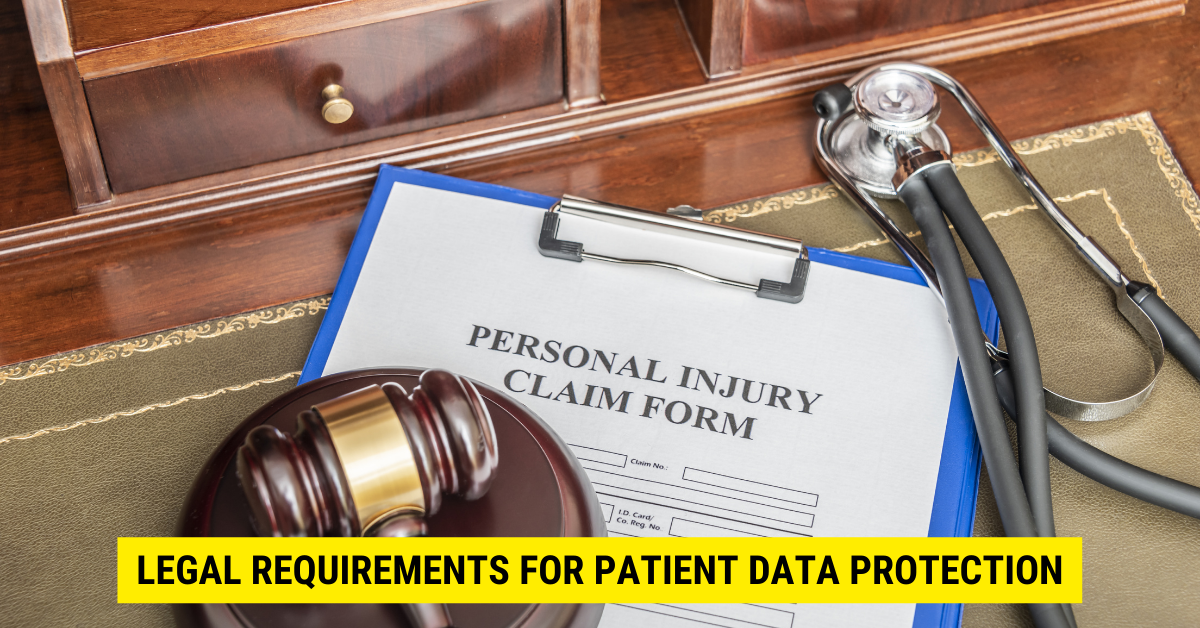To encrypt patient data, first assess which specific data needs encryption. Then, choose the appropriate encryption method, such as symmetric or asymmetric encryption, and implement strong encryption algorithms like AES or RSA. Ensure data is encrypted both at rest using encryption tools or software and in transit using secure protocols like HTTPS or VPN. Secure encryption keys and employ access controls and authentication mechanisms. Stay updated with encryption technologies and compliance regulations, and train staff accordingly. Regularly conduct audits to identify and address vulnerabilities promptly.
In today’s digital age, protecting patient data is paramount in the healthcare industry. With the increasing threat of cyberattacks and data breaches, healthcare organizations must proactively safeguard sensitive information. One indispensable tool in this battle is data encryption. By encrypting patient data, healthcare providers can ensure that only authorized individuals can access and decipher the information, providing an additional layer of security.
Understanding the Importance of Patient Data Encryption
Before delving into the intricacies of data encryption, it is crucial to grasp its significance within the healthcare sector. Patient data is a treasure trove of personal and sensitive information, ranging from medical records to payment details. This data can be compromised without proper protection, leading to severe consequences for patients and healthcare providers.
When it comes to healthcare, privacy, and confidentiality are of utmost importance. Patients trust healthcare providers with their most intimate and personal information, and it is the providers’ responsibility to ensure this information remains secure. Data encryption plays a vital role in achieving this goal.
The Role of Data Encryption in Healthcare
Data encryption safeguards against unauthorized access or interception of patient information. It ensures that even if a third party gains access to the data, it remains inaccessible without the encryption key. This means that even if a hacker manages to breach the security measures of a healthcare organization, they will be faced with encrypted data that is virtually impossible to decipher without the encryption key.
By encrypting patient data, healthcare organizations can maintain the confidentiality and integrity of sensitive information. Encryption algorithms scramble the data into an unreadable format, making it useless to anyone who does not possess the encryption key. This protects patients’ personal information and helps prevent identity theft, fraud, and other malicious activities.
Furthermore, data encryption enhances trust and confidence among patients. When individuals know their data is protected through encryption, they are more likely to share accurate and complete information with their healthcare providers. This, in turn, enables healthcare professionals to make well-informed decisions and provide the best possible care.
Legal Requirements for Patient Data Protection

In addition to ethical considerations, legal obligations demand healthcare providers to protect patient data. Legislation, such as the Health Insurance Portability and Accountability Act (HIPAA), mandates implementing appropriate security measures, including data encryption, to safeguard patient information.
HIPAA sets strict guidelines for handling and storing patient data, requiring healthcare organizations to implement administrative, physical, and technical safeguards. Data encryption is specifically mentioned as an effective method for protecting electronic protected health information (ePHI).
Failure to comply with these requirements can result in severe penalties and reputational damage. Healthcare providers can face hefty fines, legal consequences, and loss of trust from patients and the public if they fail to protect patient data adequately.
It is important to note that data encryption is not a one-time implementation but an ongoing process. As technology advances and new threats emerge, healthcare organizations must continuously update and strengthen their encryption protocols to stay ahead of potential risks.
In conclusion, patient data encryption is a critical component of healthcare cybersecurity. It protects sensitive information from unauthorized access and ensures compliance with legal requirements. By implementing robust encryption measures, healthcare organizations can safeguard patient data, build trust, and uphold the privacy and confidentiality that patients deserve.
Basics of Data Encryption
Before diving into the practicalities of encrypting patient data, it is essential to understand the fundamentals of data encryption.
Data encryption is a critical aspect of data security that ensures the confidentiality and integrity of sensitive information. It involves transforming plain, readable data into an unreadable format using mathematical algorithms. This encrypted data can only be deciphered and accessed by authorized parties with the encryption key, providing a robust layer of protection against unauthorized access and data breaches.
Encryption is vital in various industries, including healthcare, finance, and government sectors, where protecting sensitive data is paramount. Organizations can safeguard their valuable information from threats by implementing data encryption techniques and ensuring compliance with data protection regulations.
What is Data Encryption?
Data encryption converts plain, readable data into an unreadable format using mathematical algorithms. This transformation is achieved by applying a cryptographic key to the original data, resulting in the ciphertext. The ciphertext is a jumbled combination of characters that appears random and unintelligible to unauthorized individuals.
The encryption process involves two main components: an encryption algorithm and an encryption key. The encryption algorithm determines how the data will be transformed, while the encryption key acts as a unique code that allows authorized parties to decrypt the encrypted data and restore it to its original form.
Data encryption provides a secure and reliable method of protecting sensitive information during storage, transmission, and processing. It ensures that even if unauthorized individuals gain access to the encrypted data, they cannot understand or utilize it without the encryption key.
Different Types of Data Encryption Techniques
There are various encryption techniques available, each with its strengths and weaknesses. Understanding the different types of encryption is crucial in selecting the most appropriate method for encrypting patient data.
- Symmetric Encryption: Symmetric encryption, also known as secret-key encryption, uses a single key for encryption and decryption. The same key encrypts the data at the sender’s end and decrypts it at the receiver’s end. This relatively fast and efficient encryption technique makes it suitable for encrypting large amounts of data. However, the main challenge with symmetric encryption is securely distributing and managing the encryption key.
- Asymmetric Encryption: Asymmetric encryption, also known as public-key encryption, employs a pair of public and private keys. The public key is encrypted, while the private key is kept secret and used for decryption. This encryption technique provides a higher security level than symmetric encryption, as the private key remains confidential. Asymmetric encryption is commonly used in secure communication protocols, such as SSL/TLS, to establish secure connections over the Internet.
- Hashing: Hashing is a one-way encryption technique that converts data into a fixed-length string of characters, known as a hash value. The hash value is unique to the input data, meaning that even a small change in the original data will result in a completely different hash value. Hashing is commonly used for data integrity checks, password storage, and digital signatures.
Each encryption technique has its advantages and disadvantages, and the choice of encryption method depends on various factors, including the level of security required, the type of data being encrypted, and the specific use case.
It is important to note that data encryption is just one aspect of a comprehensive data security strategy. Organizations must also implement other security measures, such as access controls, firewalls, and regular security audits, to protect sensitive information.
Step-by-Step Guide to Encrypting Patient Data

Preparing for Data Encryption
Before embarking on the encryption journey, healthcare organizations must ensure they are adequately prepared.
Ensuring the security of sensitive patient data is paramount in the healthcare industry. As technology continues to advance, so do the threats to data privacy and security. Healthcare organizations need to implement robust data encryption measures to safeguard patient information from unauthorized access. However, before diving into the encryption process, it is crucial to take certain preparatory steps to ensure a smooth and effective implementation.
Assessing Your Current Data Security Measures
Conducting an in-depth analysis of existing data security measures is vital to identify potential vulnerabilities and areas for improvement. It is essential to have a comprehensive understanding of the current data infrastructure and security protocols in place. This assessment helps healthcare providers understand their data infrastructure better and determine the most appropriate encryption strategies.
The assessment evaluates the effectiveness of security measures, such as firewalls, intrusion detection systems, and access controls. It also includes reviewing policies and procedures related to data handling, storage, and transmission. By conducting a thorough assessment, healthcare organizations can identify any weaknesses or gaps in their security measures and take proactive steps to address them.
Furthermore, the assessment should also consider the regulatory requirements and industry best practices related to data security. Compliance with regulations such as the Health Insurance Portability and Accountability Act (HIPAA) is crucial for healthcare organizations. Identifying and addressing any compliance gaps is an essential part of the preparation process.
Identifying the Data to be Encrypted
Not all data may require the same level of encryption. To optimize the encryption process, healthcare organizations should identify the specific types of patient data that require encryption, such as medical records, social security numbers, or banking information. This targeted approach ensures the efficient allocation of resources.
Healthcare organizations should consider the sensitivity and criticality of different data types during the identification process. For example, medical records contain highly personal and sensitive information, making them a prime target for unauthorized access. On the other hand, general administrative data may not require the same level of encryption.
Additionally, it is essential to consider the data’s lifecycle and its various stages, from creation to disposal. Understanding when and where data is most vulnerable can help healthcare organizations prioritize encryption efforts. For instance, data in transit, such as information being transmitted between healthcare providers or to patients, may require stronger encryption measures compared to data at rest, which is stored within the organization’s systems.
Healthcare organizations can focus their efforts on protecting the most critical and sensitive information by identifying the specific data elements that require encryption. This targeted approach ensures that resources are allocated efficiently and effectively, maximizing the overall security posture.
Choosing the Right Encryption Software

When it comes to encryption, not all software is created equal. Selecting a robust encryption software that aligns with your organization’s needs and security requirements is crucial. Thoroughly research different options, considering factors such as encryption strength, ease of use, and vendor reputation.
Implementing the Encryption Process
Implementation involves defining encryption policies, establishing encryption parameters, and deploying the encryption software across the organization’s systems and networks. The proper implementation ensures consistent and comprehensive data encryption.
Testing the Encryption
Before fully adopting the encryption process, it is essential to conduct rigorous testing to ensure its effectiveness and compatibility. Test scenarios should encompass various use cases and potential vulnerabilities, allowing for any necessary adjustments or refinements.
Maintaining and Updating Your Encryption Practices
Data encryption is an ongoing process requiring continuous maintenance and updates to stay ahead of evolving threats.
Regularly Updating Your Encryption Software
Encryption software must be regularly updated to address newly discovered vulnerabilities and incorporate the latest security patches. Neglecting software updates can leave your encrypted data exposed to potential breaches.
Training Staff on Data Encryption Practices
Effective encryption practices rely on the cooperation and awareness of all staff members. Regular staff training sessions should be conducted to ensure a proper understanding of data encryption protocols and best practices.
Key Takeaways
- Protecting patient data is crucial in the healthcare industry, and data encryption is indispensable.
- Data encryption ensures the confidentiality and integrity of patient information by safeguarding it against unauthorized access or interception.
- Encryption algorithms scramble the data into an unreadable format, making it useless without the encryption key.
- Data encryption enhances patient trust and helps healthcare providers comply with legal requirements like HIPAA.
- Symmetric encryption uses a single key for encryption and decryption, while asymmetric encryption uses a pair of keys.
- Proper preparation, including assessing current security measures and identifying the data to be encrypted, is essential.
- Choosing the right encryption software, implementing the encryption process, testing the encryption, and maintaining and updating encryption practices are key steps in encrypting patient data.
- Regular updates to encryption software and staff training on encryption practices are crucial for maintaining the security of patient data.
FAQs
How can I encrypt patient data in healthcare systems?
To encrypt patient data in healthcare systems, you can implement robust security measures such as encryption algorithms, securing databases, and utilizing access controls. Additionally, secure communication protocols and regularly updating security patches are essential for protecting patient information.
What are the benefits of encrypting patient data?
- Encrypting patient data provides several benefits, including:
- Enhanced data security: Encryption ensures that patient information remains confidential, even if unauthorized individuals gain access to the data.
- Compliance with regulations: Encrypting patient data helps healthcare organizations comply with data protection regulations, such as HIPAA (Health Insurance Portability and Accountability Act) in the United States.
- Building trust: Encrypting patient data demonstrates a commitment to protecting sensitive information and building trust with patients and stakeholders.
Are there any challenges in encrypting patient data?
While encrypting patient data is crucial, there can be challenges. Some common challenges include:
- Performance impact: Encryption can require additional processing power and affect system performance. Implementing efficient encryption methods and optimizing systems can help mitigate this challenge.
- Key management: Properly managing encryption keys is crucial for effective data encryption. Establishing key management protocols and ensuring secure key storage is essential to overcome this challenge.
Conclusion
This step-by-step guide allows healthcare providers to establish robust encryption practices to protect their patients’ sensitive data. With the ever-increasing threat landscape, ensuring the confidentiality and integrity of patient information is essential to maintaining trust and upholding ethical obligations in the healthcare industry.
